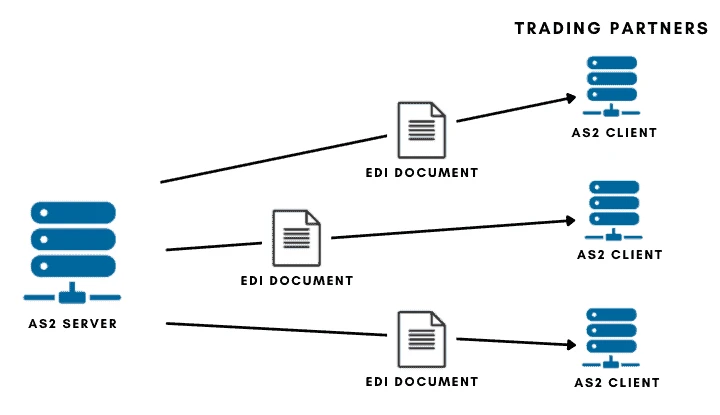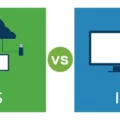AS2, or Applicability Statement 2, is an HTTP-based protocol for securely, inexpensively, and quickly transmitting messages (particularly EDI messages). It is the most widely used EDI protocol today and has been so for the past two decades.
AS2 operates over networks running the TCP/IP protocol and requires that the receiving computer be connected to the Internet at the time of sending. It uses TLS/SSL to encrypt communication channels and S/MIME for encrypting actual information.
How Does AS2 Work?
The user sends a document or transmission via the communication channel established by AS2. The sender then sets up their own digital signature or cryptographic key which is used to authenticate themselves as well as sign documents sent over AS2.
The recipient verifies the signature and acknowledges receipt of the message. This entire process is manual and does not require any human intervention once set up.
Once both parties have authenticated each other’s identity, they can send messages securely back and forth without having to set up multiple connections each time a new message needs to be sent. This reduces the cost, complexity, and time of data exchange significantly.
Benefits of Using AS2
There are many benefits of using AS2 for data exchange between businesses and their trading partners:
• Secure: All messages exchanged using AS2 are encrypted with TLS/SSL, making them secure from unauthorized access.
• Reliable: Messages are reliably delivered with no data loss or corruption due to built-in error detection mechanisms in place.
• Cost-Effective: Communication costs are drastically reduced due to automatic setup, which eliminates manual labor costs associated with setting up multiple connections each time a new message needs to be sent
• Fast: Data transfers occur quickly due to its HTTP-based protocol which means faster turnaround times on large transmissions such as EDI documents
• Versatile: Can handle a variety of file types including text files, XML files, PDFs, images, etc., making it ideal for different types of data exchange scenarios
Overall, AS2 provides an efficient platform for business-to-business communication that can help reduce costs while maintaining the security standards and reliability that companies need in order to conduct business successfully in today’s digital landscape.

What is the Meaning of AS2?
AS2 stands for Applicability Statement 2, which is an EDI (electronic data interchange) protocol that allows businesses to securely transfer data over the Internet. It works by using digital certificates and encryption to ensure the confidentiality and integrity of the data being sent and received. AS2 is a popular protocol among trading partners due to its reliability, scalability, and affordability.
Is AS2 Still Relevant?
Yes, AS2 (Applicability Statement 2) is still used today. It has become the most widely adopted EDI protocol for securely and quickly transmitting messages in many industries, including consumer goods and retail. Over the last two decades, AS2 has become increasingly popular for its cost-efficiency, reliability, and ease of use.
In addition to its long-standing use in EDI transactions, AS2 is also utilized in other areas such as healthcare and government applications. Many leading software companies provide support for AS2, and it continues to be a popular choice among those looking to securely exchange data over the internet.
Overall, AS2 remains one of the most reliable and trusted protocols available today for exchanging data between organizations. Its versatility and wide range of applications make it an ideal solution for securely transferring sensitive information over the web.
Comparing AS2 and SFTP
The primary difference between AS2 and SFTP is how the secure connection between the client and server is established. AS2 uses Transport Layer Security (TLS) and Secure/Multipurpose Internet Mail Extensions (S/MIME) to encrypt the communication channel and information, whereas SFTP uses Secure Shell Protocol (SSH).
In addition, AS2 supports non-repudiation, which provides a digital timestamp for proof of delivery. This can be useful for ensuring that documents have not been modified after delivery. SFTP does not offer this feature, although it does offer other features such as directory listing, file locking, and data compression.
Overall, AS2 is a more secure protocol than SFTP; however, it may not be suitable for all applications due to its requirement for additional hardware or software components. On the other hand, SFTP requires fewer resources but lacks the same high level of security as AS2.
The Difference Between EDI and AS2
The main difference between EDI (Electronic Data Interchange) and AS2 (Applicability Statement 2) is the method of communication between two trading partners. EDI is a protocol that enables the exchange of structured data in a predetermined format over a variety of networks, including dedicated lines, dial-up connections, or the Internet. AS2, on the other hand, is an Internet-based protocol that uses the Secure Hypertext Transfer Protocol (S-HTTP) to securely transport data over the Internet.
AS2 offers several advantages over traditional EDI. For instance, AS2 is more secure than EDI as it utilizes public key cryptography to encrypt and digitally sign messages before they are transmitted. This ensures that both parties are able to verify each other’s identity prior to exchanging any sensitive information. Additionally, AS2 supports non-repudiation of receipt, meaning that the sender can prove that the message was received by its intended recipient without having to rely on third-party services or proof of delivery documents. Finally, while EDI often requires expensive dedicated hardware and software for communication between trading partners, AS2 requires only an internet connection and compatible software for both parties. This greatly reduces setup costs for businesses that wish to use this type of technology for exchanging information with their trading partners.
The AS2 Protocol in EDI
AS2 (Applicability Statement 2) is a standard protocol used to transmit EDI messages over the internet. It was developed in the late 1990s as a secure and reliable alternative to traditional EDI technologies such as FTP and VANs. AS2 delivers messages using HTTP/S, allowing for easy integration with existing web infrastructure. AS2 also provides features such as message encryption, digital signatures, non-repudiation, and receipts that help ensure data security and accuracy. As a result, it has become the preferred EDI protocol for many industries such as retail and consumer goods, where secure and efficient electronic data interchange is essential.
Differences Between AS2 and FTP
The primary difference between File Transport Protocol (FTP) and Applicability Statement two (AS2) is the security features that AS2 provides. FTP is a protocol used to transfer files between computers over the Internet, while AS2 is an application-level protocol that provides secure file transfer capabilities. With FTP, data is transferred in plain text and can be intercepted and read by anyone with access to the network. AS2, on the other hand, uses digital certificates and encryption to protect the data being transferred. Additionally, AS2 enables message acknowledgments which allows for reliable delivery of messages as well as non-repudiation of origin which ensures that the sender of a message can’t deny having sent it. This makes it more suitable for use in business transactions than FTP. Furthermore, AS2 supports larger file sizes than FTP due to its highly compressed data format and can also send files over longer distances without interruption.
Differences Between AS2 and SSL
AS2 and SSL are both secure protocols used for data transmission over the internet. The main difference between them is that AS2 does not require a Certification Authority (CA) signed certificate to be trusted by trading partners, whereas SSL does. This means that with AS2, Key Pairs, and Certificates are usually generated locally and self-signed, and then the certificate is distributed as a DER or PEM encoded file.
SSL on the other hand requires an SSL Certificate from a CA in order to be trusted by the browser. This process can involve requesting a certificate from the CA, submitting your domain name and other information, verifying domain control, installing the certificate on the server, configuring your server to use it, and more.
Both AS2 and SSL provide secure connections though; with AS2 you have more control over encryption settings as it is not tied to a single CA like with SSL. Additionally, AS2 also supports non-repudiation which allows for stronger digital signatures than what is available with SSL.

Source: venafi.com
Understanding AS2 in B2B Transactions
AS2 (Applicability Statement 2) is a protocol used for the secure and reliable transmission of structured business-to-business (B2B) data over the internet. This protocol ensures the highest level of security by using digital certificates, encryption, and message compression, making it the preferred choice for B2B transactions. AS2 works by sending messages that contain information about a transaction from one business to another. The recipient’s system receives and decrypts the message, validates the digital certificate, and then sends a response back to the sender confirming the transaction was successful. AS2 also provides non-repudiation which is an assurance that a transaction has taken place and cannot be denied by either party later on. With this protocol, businesses can quickly share information with their trading partners in an efficient, secure, and reliable manner.
The Security of AS2 Over HTTP
Yes, AS2 over HTTP is secure. The HTTPS protocol used by AS2 encrypts data while in transit to prevent eavesdropping and tampering. An SSL certificate is also required to ensure the identity of the trading partners and verify that the communication is secure. Additionally, S/MIME encryption can be applied for further protection of the data being transferred. Finally, file hashing can be used to detect any changes or alterations to the data during transmission. All these measures make AS2 over HTTP a highly secure method of data exchange between trading partners.
Conclusion
In conclusion, AS2 (Applicability Statement 2) is a secure and efficient EDI protocol that allows businesses to exchange data with their trading partners. It provides several advantages over traditional EDI methods, such as encryption of communication channels and S/MIME encryption of actual information. Furthermore, AS2 runs over TCP/IP networks, meaning the receiving computer must be connected to the Internet at the time the document is sent. As a result, its usage has grown significantly in industries such as consumer goods and retail over the last 20 years.








